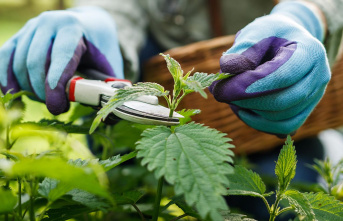It rained a lot in 2023. A lot, actually. This was good for the groundwater table, even desperately necessary. In the home garden, however, the wet summer caused disappointment and frustration. Not only in terms of the harvest, but also for the following season: The fact is that the rain was a real blessing for unwanted guests like snails. In addition, the mild winter contributed to the fact that the molluscs could have produced offspring well into December. And it is now hatching in spring – with a great appetite for fresh green. Since we have already looked at how you can fight snails, in this article we would like to address the question of whether there are plants that the animals are not interested in.
Before we address the question of whether there are snail-resistant plants, we would like to point out once again that not all molluscs in the garden are after your vegetables. "Most shell snails, such as the common banded snails, are practically unimportant as pests. They live mainly on dead plant material. The large garden snail - which is, by the way, a protected species - even helps the gardener because it also eats the slugs' eggs." , the Nature Conservation Association of Germany (NABU for short) points out.
The tiger slug is also no threat to the garden. Quite the opposite: the slug feeds mainly on decaying plant parts and dead animals. The situation is different with the Spanish slug, the garden slug and the field slug: these species are mollusks that have a particularly large appetite and can literally eat entire fields bare. It remains to be seen whether they will really be driven out of the garden if you plant flowers, shrubs or herbs that they find deterring. But it does help if they avoid the plants.
It's not just snails that avoid your prickly thistles. Nevertheless, their silvery to light blue flowers, which appear in summer (July to September), are an important source of food for bees and insects. The easy-care and drought-tolerant plant prefers a sheltered and sunny location, but also grows in partial shade.
This plant has several advantages: Not only does it suppress unwanted weeds, it also drives away snails (and ants). What's more, its mostly red or yellow flowers are edible - if they aren't covered in aphids. Although nasturtiums don't tolerate frost, they can simply be re-sown every year.
Whether pink, red, white or multicolored: peonies are a true phenomenon in the garden. Although the intensely colored flowers only appear in early summer, the perennial and hardy fragrant perennials are avoided by snails all year round. As far as the ideal location is concerned, the plants prefer a sunny to partially shaded spot.
The hardy, perennial wild perennial Columbine 'Earlybird Red Yellow' doesn't have to be afraid of snails either. Its red-yellow flowers, which offer bees plenty of nectar, appear in their full glory (best in a sunny to partially shaded location) between May and July - in beds as well as in planters. Another plus point: The maintenance effort should be very low.
The colorful cut flowers are probably also avoided by snails. From April you can even sow the seeds directly outdoors - it doesn't matter whether you want to grow the snapdragon mixture (Antirrhinum majus) on the balcony, in the bed or in the rock garden. The only important thing is that you choose a sunny to partially shaded spot.
Not only are there lots of flowers and perennials that snails avoid, but also herbs. The essential oils it contains are said to even have a deterrent effect on the molluscs - but this theory has not been scientifically proven. Either way, herbs are a real eye-catcher on the balcony or in the garden. They can also be used as spices. And their flowers are an important source of food for many insects. Below we list a few herbs that snails avoid and are therefore used between susceptible plants:
But be careful: basil, dill, marjoram and (young) parsley are an exception - because these herbs are often eaten by slugs.
Sources: NABU, Geo
This article contains so-called affiliate links. Further information are available here.












